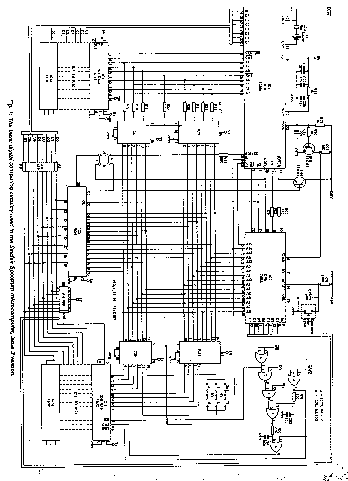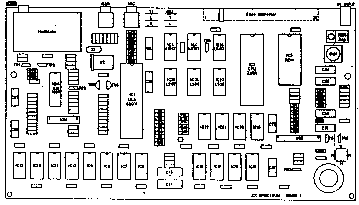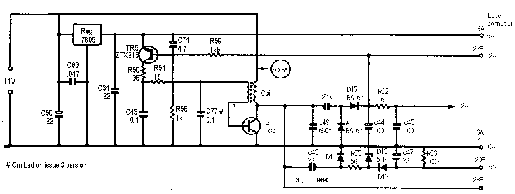|
Servicing
Sinclair Computers Part 3
This month we start On the
Spectrum. Let's first take a quick look at the development of
this machine over the past few years. There have been four
standard PCBs marked issue 1, 2, 3 and 3B. After each change a
few modifications were generally required to make the new design
operational or to implement further improvements - even the 3B
board has now been modified. It's often possible to determine the
issue number without opening the case. The clues are as
follows:
(1) If the rubber keys are a light fawn colour it's an issue 1
board.
(2) If the keys are dark grey, look into the edge connector slot
to see whether an aluminium heatsink is visible -especially at
the power socket end. If you don't see the heatsink it's an issue
2 board which has the heatsink near the forward corner of the
board, under the keyboard.
(3) If the heatsink is visible it's an issue 3 or 3B board -
there is very little difference between them.
The Spectrum Plus usually has an issue 3B board, but watch for
earlier models that have been fitted with a Spectrum Plus
keyboard kit - this can now be obtained separately.
In this write-up I shall be dealing primarily with issue 3 and
3B models, though I hope to mention the earlier models where the
differences are important.
Circuitry
The Spectrum differs from the ZX81 (see last month) in two major
respects. First it's designed to carry the full memory (48K RAM)
on the PCB. Secondly the TV display is serviced automatically by
the ULA chip and a dedicated ic. (type LM1889) which also
provides the video output in colour. This latter arrangement
explains why with an otherwise dead machine a vertical striped
pattern of "bricks" flickers up and down the screen and goes on
working even when the CPU has been removed.
Which reminds me - I haven't explained why we're not providing a
block diagram for the Spectrum. I don't see that this would be of
much advantage. Apart from illustrating the two differences I've
just mentioned it would be much the same as the block diagram
given for the ZX81. Instead I'm showing most of the circuitry.
Which by now should be fairly self-explanatory.

Fig1. (Thumbnail. Click herefor full size)
The basic digital computing circuitry used in the Sinclair
Spectrum Issue 3
The first circuit section is shown in Fig. 1. This includes the
basic digital computing circuitry. For clarity, most of the
decoupling and smoothing capacitors have been omit-ted. The
input/output circuitry, including the TV output, tape input and
output and the keyboard connections have also been omitted: these
will be shown later.
Fig. 2 shows the layout of the issue 3 Spectrum to enable you to
find the main components as we refer to them. The differences
between this and the issue 2 board are not very great. Because of
the changed position of the heatsink, the keyboard socket at the
right-hand side of the board has been moved slightly rearwards
and the regula-tor is in the middle of the right-hand edge. Most
of these features become obvious when you compare an earlier
issue board with the layout shown in Fig. 2.

Fig.2 (Thumbnail, Click herefor full size)
Layout of the issue 3 Spectrum panel.
Access
You can't do that however till you open up the machine, so here
goes:
(1) Turn the machine over and
remove the five screws - eight with the Spectrum Plus.
(2) Turn it back, carefully holding the two parts together. Lift
the top, tipping it on to its rear edge so that the keyboard
tails can be removed from their sockets. Remember what we said
when dealing with the ZX81 about the fragile nature of these
tails: the Spectrum is just as vulnerable in this respect.
(3) As with the ZX81, the machine should still initialise when
the keyboard has been disconnected, and on start up should
display 'c 1982 Sinclair Research Ltd." on the bottom line. The
keyboard can be left disconnected until this has been
achieved.
(4) Before much serious work can be undertaken the heatsink must
be removed to provide access to the components beneath. This is
even more important with issue 3 and 3B models which have a
larger heatsink that covers many of the more important
components. The temporary heatsink I use when working on any
Spectrum board is shown in Fig. 3. Don't worry if you cannot find
a piece of copper or aluminium exactly the right size - the only
important section is the little bent-up end which has to fit
under the regulator. Even here, if your metal is too thin you can
stick another shim of metal to the back so that the regulator
legs are not distorted when you screw the heatsink underneath
it.

Fig.3 Temporary heatsink for use when
carrying out servicing work on the Spectrum.
Fault
Finding
The internal voltage generator circuit is shown in Fig. 4. This
is one of the circuit areas that often suffers when a fault
develops. It consists of a 5V regulator and a blocking oscillator
(TR4) whose output is rectified to produce the 12V and -5V lines
required by the 4116 memory i.c's that provide the initial 16K of
RAM. An interesting regulation technique is used: the blocking
oscillator's timing capacitor(s) are charged by the
constant-current transistor TR5 whose base is controlled by
feedback from the 12V line. The outputs are taken to the edge
connector and perhaps this is the problem. It seems that TR4 dies
when there's the slightest extra load. This is often caused by a
joystick interface being removed or fitted while the machine is
switched on and probably shorting out one of the supplies. But
the 4116 memory ic's sometimes develop shorts and then he
problems start.
I've shown the oscillator current in Fig. 4. It's often
necessary to supply the board from a bench supply and monitor
this current. With a supply provided for the 5V rail, wind up he
supply to the oscillator slowly from zero. Monitor the current
drawn by the oscillator: if the reading exceeds 300rnA switch off
quickly and remove one/some of the memory ic's or cut the 12V
supply tracks to pin 8.
Finding the faulty memory or memories is very hit and miss but
if you've a good record at pontoon or the football pools you may
be lucky!
Earlier circuits were slightly different from the issue 3/3B
circuit shown but the differences were often only in the
component values and it's worth noting that all issues use the
same component reference number for compo-nents in the same
circuit position.
One more point. Because of the omission in earlier versions of
the asterisked 22uF electrolytic capacitor, unless you have the
3B version the 12V line will be at about 11v even when the
oscillator is not working. This can present a very confusing
situation, so ensure that your first check is always on the -5V
line, which will be absent if the oscillator isn't working. The
frequency of oscillation, which isn't very critical - or stable -
is about 6.6kHz.

Fig.4 (Thumbnail. Click herefor full size)
Voltage generator circuit used in the Spectrum - Issue 3B
version. With the issue 3 version R60 is 270 Ohm, C49 is 47nF and
the hashed components are omitted. Edge connector numbers
suffixed A are on the underside of the board, those suffixed B
are on the component side (top). The input from the power supply
is approx. 11V on load (650mA)
Having eliminated faults in the voltage generator circuit and
hopefully in any of the 16K RAMs, why doesn't the thing work?
Assuming that you are still getting the flickering vertical
columns the ULA and the TV video generator chip appear to be
o.k., so what else? Remem-ber that your check on the memory ic's,
made whilst repairing the voltage generator (if necessary),
detected only those ic's taking excessive current, not those with
other faults. So first try the piggy-back check I suggested for
the ZX81 last month. Clip a good 4116 on top of each of the
remaining original memories and see whether this makes a
difference. If the extension memory chips (IC15 - IC26) are
fitted they can be tuned off either by removing the memory chips
or IC25 (one of the 74LS157 multiplexer chips). Altema6vely the
5V supply track to pin 16 of this ic. can be cut, but this is not
easy with the issue 3 board as the track is thicker than
usual.
The 4116 memories are also addressed via the 74LS157
multiplexers IC3-4. You may recall our earlier comment that
dynamic RAMs such as the 4116 are addressed by a row/column
sequence so that only half the theoretically required number of
address pins are needed. The internal system stores the first
half of the address and then combines it with the second half to
provide the full 16-bit address. The ULA has this facility built
in, so it doesn't require multiplexers to address the RAMs.
Note the buffer resistors in the address lines between the ULA
and multiplexers IC3-4. These allow the ULA to take control of
the address bus when the screen needs updating, irrespective of
the demands of the CPU. These buffer resistors are very useful
when you are fault finding. Any loss of signal tends to be
isolated to one side of the buffer, enabling the faulty ic. to be
detected. In this case if the fault is on the ULA/RAM side
removing the ULA or cutting the track will usually pinpoint the
fault.
If you still have a fault, it's probably in the CPU or the ROM
and a full check on the circuit will be necessary. Table 1 shows
the signals that should be present at each pin of the main ics,
with the keyboard connected and the Sinclair logo displayed, when
monitored using a logic probe (a Tandy Micronta was used). This
should enable you to isolate and replace the faulty ic.
Next month we'll look at the rest of the circuit and some of the
variations and modifications.
| Pin |
IC1 |
IC2 |
IC5 |
IC6 |
IC15 |
| 1 |
P |
P |
OC |
L |
L |
| 2 |
PH |
PH |
PH |
P |
P |
| 3 |
P |
P |
PL |
PH |
PH |
| 4 |
PH |
P |
P |
P |
P |
| 5 |
P |
P |
P |
P |
P |
| 6 |
P |
P |
P |
P |
P |
| 7 |
P |
P |
P |
P |
P |
| 8 |
P |
P |
P |
H |
H |
| 9 |
P |
P |
P |
H |
H |
| 10 |
P |
P |
P |
P |
P |
| 11 |
P |
H |
P |
P |
P |
| 12 |
PH |
P |
P |
P |
P |
| 13 |
H |
P |
P |
P |
P |
| 14 |
H |
P |
L |
P |
P |
| 15 |
P* |
P |
P |
P |
P |
| 16 |
P* |
PH |
P |
L |
L |
| 17 |
PH |
H |
P |
† |
† |
| 18 |
P |
H |
P |
† |
† |
| 19 |
H |
P |
P |
† |
† |
| 20 |
H |
PH |
P |
† |
† |
| 21 |
P |
P |
P |
† |
† |
| 22 |
P |
PH |
P |
† |
† |
| 23 |
H |
H |
P |
† |
† |
| 24 |
H |
H |
P |
† |
† |
| 25 |
P |
H |
P |
† |
† |
| 26 |
H |
H |
P |
† |
† |
| 27 |
P |
P |
P |
† |
† |
| 28 |
L |
P |
P |
† |
† |
| 29 |
P |
L |
† |
† |
† |
| 30 |
P |
P |
† |
† |
† |
| 31 |
P |
P |
† |
† |
† |
| 32 |
P |
P |
† |
† |
† |
| 33 |
PH |
P |
† |
† |
† |
| 34 |
P |
P |
† |
† |
† |
| 35 |
P |
P |
† |
† |
† |
| 36 |
P |
P |
† |
† |
† |
| 37 |
P |
P |
† |
† |
† |
| 38 |
P |
P |
† |
† |
† |
| 39 |
T |
P |
† |
† |
† |
| 40 |
L |
P |
† |
† |
† |
|



